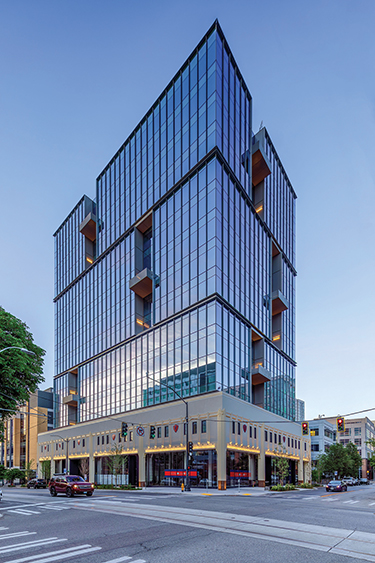|
Subscribe / Renew |
|
|
Contact Us |
|
| ► Subscribe to our Free Weekly Newsletter | |
| home | Welcome, sign in or click here to subscribe. | login |
Architecture & Engineering
| |
 |
February 29, 2024
Seattle’s commercial development at a crossroads
Perkins&Will

Mott
|
The future of commercial development in Seattle’s downtown core is more uncertain than ever. The bullish trend of the recent decade of development has given way to a disquieting lull that begs the question, “What next”?
While none of us can predict the future, it is increasingly clear that development in Seattle will look different in the coming years to serve the expectations and needs of future generations. During this hopefully momentary lull in development investment, we can reflect on how to best shape the future of our downtown intentionally. With a shared vision, we can act together to have the most positive impact on our urban and natural environment.
INERTIA AND UNCERTAINTY
There are amazing opportunities ahead, as well as systemic challenges to overcome. Economic momentum has shifted away from growth, and we are now faced with inertia and uncertainty as market leaders contemplate their next move. Those in and associated with the commercial real estate and development industry can see the challenges ahead, and it’s a common refrain that “this time feels different” due to cultural and economic shifts with impacts that remain unknown. What we do know is that downtown is struggling to recover its pre-pandemic vitality, and that additional growth and development will be challenging. Fundamental shifts in financial markets and social behaviors arising from the pandemic have made visible impacts on the downtown core and the outlook for the foreseeable future. One catalyst for change is to make a shared commitment to improved public and private cooperation to overcome the current dilemma.
According to JLL’s Global Real Estate Outlook in Summary, at the end of 2023, return to office rates in the U.S. were at a meager 55%, significantly lower than in Europe (75%) or Asia-Pacific (85%). In Seattle, the trend towards remote work has shown up as the greatest decline in demand for office space among seven major cities including Los Angeles, San Francisco, Boston, Washington, D.C., New York, and Chicago, according to commercial real estate analysis by VTS. Downtown recovery is hovering at about half of pre-pandemic levels of 2019 according to a University of Toronto study analyzing 66 cities in North America.
While many socioeconomic factors may contribute to Seattle’s significant lag in economic and civic recovery, the impacts are visible on streets and sidewalks that lack activity. They are lined with vacant retail storefronts, projecting a feeling of decline. With significant vacancies and an absence of multi-family residential density in the center of the city, Seattle has become less inviting to a healthy and industrious populace.
RESTORING AND REGENERATING OUR URBAN FABRIC
Against this backdrop, the commercial development pipeline in Seattle has slowed substantially with a sharp decrease in immediate demand and uncertainty of future demand. By late 2023, only 15 commercial building permits had been issued downtown, as compared to more than 100 in 2016 and an average of 65 per year between 2016 and 2019, according to the DSA 2023 Year End Development Guide.
That may seem like grim news. Absent a new trend emerging, it could be. But there is good news too. The Seattle region remains in a robust economic position as a home for global leaders and is a beautiful natural setting with a community known to be resilient, innovative, progressive, and socially conscious. Surely, we can turn the development trend upward again by taking this opportunity to knit together public and private investments toward a shared goal of a restored and regenerated urban fabric.
A true recovery can only take place when community leaders align around proactive coordinated strategies to promote and deliver quality urban development. City and community leaders are to be lauded for bringing forward the Downtown Activation Plan, the Building Emissions Performance Standard (BEPS), and the Third Avenue Vision Initiative. More needs to be done.
These visions, accompanied by meaningful public investments in Seattle’s future could amplify the benefits of a healthy downtown. Modifying the zoning, regulatory, and fee framework could truly unlock the future potential of downtown. Other improvements that could make a huge difference in activating progress include incentivizing and rewarding developers for creating intelligent density in mixed-use neighborhoods, simplifying the outdated zoning code, eliminating height limits throughout downtown, and striking through regulatory impediments that overburden the risk and cost side of every proforma.
Development is a sign of life, vitality and civic health. We must connect the dots between our economic and cultural goals and the built environment, and work together to find creative solutions to support development. Given the profound recent shifts in macro-economic trends and social norms, it is no wonder that mature cities with more well-established density, diversity, and public space are recovering faster. Seattle, this is a collective learning moment.
Beyond policy, code revisions, and enhanced public and private partnerships, forward-looking leaders are revisiting expectations for design and construction to address what people want today and in the future. Innovations have made their way into the skyline through projects that embrace new paradigms for use and new standards of performance.
The next tranche of development in Seattle will bring a steep change in the evolution of quality projects as citizens, tenants, and residents demand healthier, more distinctive, and inviting buildings and spaces to fulfill the potential of a flexible and healthy urban lifestyle. New city initiatives alongside new development standards can shape the future of commercial development in the Seattle downtown core. Only time will tell if we are up for choosing the right path.
Erik Mott is principal and design director at Perkins&Will.
Other Stories:
- The need for high-performance building enclosure design
- Designing library spaces for the children of today
- Bypassing review to boost affordability
- Designing for health in affordable housing
- Disrupting inequality in housing
- Trends transforming life-science building design
- Eight trends shaping design for cities in 2024
- Centering the patient and community in rural healthcare design
- Engineering with support from the sky
- Transforming yesterday’s spec office into the destination workplace of tomorrow
- An uncertain forecast for middle housing



